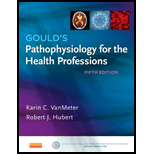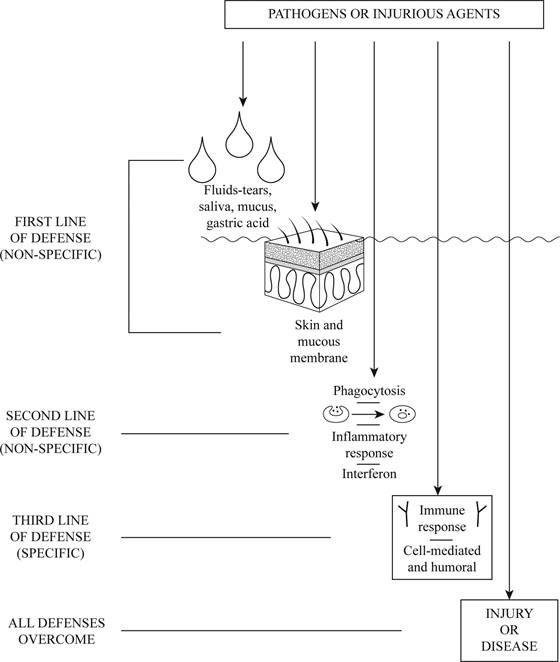
Concept explainers
To explain: The role of normal defenses in preventing disease.
Concept introduction: Organisms use defense mechanisms to protect from any injurious agent. This can be specific or non-specific.
Explanation of Solution
The defense mechanisms are generally classified into three lines of defense as follows:
- First line of defense
- Second line of defense
- Third line of defense
First line of defense: It is the general, non-specific defense mechanism that includes the mechanical barrier such as skin or mucous membrane. This prevents the entry of bacteria or other harmful particles inside the tissues. Certain body secretions such as saliva or tears act as mechanical barriers. It contains enzymes or chemical substances that inactivate the potential invading particles.
Second line of defense: It is the non-specific defense mechanism that includes the process of phagocytosis and inflammation. Phagocytosis is the process in which macrophages and neutrophils engulf the invading foreign particles, cell debris, or bacteria and destroy them. Inflammation is the sequence of events that limit the effects of injury or any agent in the body. For example, interferons, which protect the healthy tissues from viruses.
Third line of defense: It is the specific defense mechanism that protects the body by stimulating the specific antibodies or lymphocytes against the invading organisms. It creates an immune response against the harmful substances to protect the body.
Pictorial representation:
Fig.1 represents the defense mechanisms of the body.

Fig. 1: Three lines of defense mechanisms in the body.
Want to see more full solutions like this?
Chapter 5 Solutions
Gould's Pathophysiology for the Health Professions, 5e
- is a nurse a leader in healthcare or a futurist?arrow_forwardwhat is your definition of a nurse?arrow_forwardDevelop a culturally sensitive health teaching plan specifically about cultural stigma about the case A patient with tuberculosis (TB), suffers from persistent coughing, weight loss, night sweats, and exhaustion. His significant problem is the cultural stigma that comes with his condition, which has led to a fear of discrimination in his society. This concern has a significant effect on his compliance to seek medical interventions. Provide Cognitive, Affective, Psychomotor and Independent, Delendent, And Collaborationarrow_forward
- Briefly explain the 6 domain of interprofessional collaboration: Role clarification, Team functioning, Interprofessional communication, Patient/client/family/community-centered care, Interprofessional conflict resolution, Collaborative leadership. Provide a specific events that nursing student would observe in a clinical setting for each domain.arrow_forwardBriefly explain the 6 domain of interprofessional collaboration: Role clarification, Team functioning, Interprofessional communication, Patient/client/family/community-centered care, Interprofessional conflict resolution, Collaborative leadership. Provide a specific event that nursing student would encounter in a clinical setting for each domain.arrow_forwardhow can we fix abnormal vital signs?arrow_forward
- Data were measured in 15 college seniors (n = 15) in a cross-sectional study of alcohol consumption. Each participant was asked their sex, year in school, the age at which they first consumed alcohol, and the number of alcoholic drinks they consume on a typical drinking night. The data are shown in Table 3.4. Generate frequency distribution tables for sex and year in school using the Data/Pivot Table and Pivot Chart Report option on the menu bar.arrow_forwardGenerate a frequency bar chart for sex using the frequency distribution table from Problem 1.arrow_forwardBriefly explain the 6 domain of interprofessional collaboration: Role clarification, Team functioning, Interprofessional communication, Patient/client/family/community-centered care, Interprofessional conflict resolution, Collaborative leadership. Provide a postive and negative sample scenario seen in the clinical setting for each domain as a nursing studentarrow_forward
- Briefly explain the 6 domain of interprofessional collaboration: Role clarification, Team functioning, Interprofessional communication, Patient/client/family/community-centered care, Interprofessional conflict resolution, Collaborative leadership. Provide a postive and negative sample scenario for each domain.arrow_forwardthe role of nurses in politics and policy makingarrow_forwardwhat can be done to improve the status of nursing?arrow_forward
 Phlebotomy EssentialsNursingISBN:9781451194524Author:Ruth McCall, Cathee M. Tankersley MT(ASCP)Publisher:JONES+BARTLETT PUBLISHERS, INC.
Phlebotomy EssentialsNursingISBN:9781451194524Author:Ruth McCall, Cathee M. Tankersley MT(ASCP)Publisher:JONES+BARTLETT PUBLISHERS, INC. Gould's Pathophysiology for the Health Profession...NursingISBN:9780323414425Author:Robert J Hubert BSPublisher:Saunders
Gould's Pathophysiology for the Health Profession...NursingISBN:9780323414425Author:Robert J Hubert BSPublisher:Saunders Fundamentals Of NursingNursingISBN:9781496362179Author:Taylor, Carol (carol R.), LYNN, Pamela (pamela Barbara), Bartlett, Jennifer L.Publisher:Wolters Kluwer,
Fundamentals Of NursingNursingISBN:9781496362179Author:Taylor, Carol (carol R.), LYNN, Pamela (pamela Barbara), Bartlett, Jennifer L.Publisher:Wolters Kluwer, Fundamentals of Nursing, 9eNursingISBN:9780323327404Author:Patricia A. Potter RN MSN PhD FAAN, Anne Griffin Perry RN EdD FAAN, Patricia Stockert RN BSN MS PhD, Amy Hall RN BSN MS PhD CNEPublisher:Elsevier Science
Fundamentals of Nursing, 9eNursingISBN:9780323327404Author:Patricia A. Potter RN MSN PhD FAAN, Anne Griffin Perry RN EdD FAAN, Patricia Stockert RN BSN MS PhD, Amy Hall RN BSN MS PhD CNEPublisher:Elsevier Science Study Guide for Gould's Pathophysiology for the H...NursingISBN:9780323414142Author:Hubert BS, Robert J; VanMeter PhD, Karin C.Publisher:Saunders
Study Guide for Gould's Pathophysiology for the H...NursingISBN:9780323414142Author:Hubert BS, Robert J; VanMeter PhD, Karin C.Publisher:Saunders Issues and Ethics in the Helping Professions (Min...NursingISBN:9781337406291Author:Gerald Corey, Marianne Schneider Corey, Cindy CoreyPublisher:Cengage Learning
Issues and Ethics in the Helping Professions (Min...NursingISBN:9781337406291Author:Gerald Corey, Marianne Schneider Corey, Cindy CoreyPublisher:Cengage Learning





